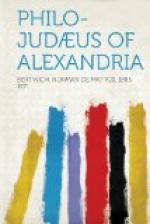If the allegorical method appears now as artificial and frigid, it must be remembered that it was one which recommended itself strongly to the age. The great creative era of the Greek mind had passed away with the absorption of the city-state in Alexander’s empire. Then followed the age of criticism, during which the works of the great masters were interpreted, annotated, and compared. Next, as creative thought became rarer, and confidence in human reason began to be shaken, men fell back more and more for their ideas and opinions upon some authority of the distant past, whom they regarded as an inspired teacher. The sayings of Homer and Pythagoras were considered as divinely revealed truths; and when treated allegorically, they were shown to contain the philosophical tenets of the Platonic, the Aristotelian, or the Stoic school. Thus, in the first century B.C.E., the Greek mind, which had earlier been devoted to the free search for knowledge and truth, was approaching the Hebraic standpoint, which considered that the highest truth had once for all been revealed to mankind in inspired writings, and that the duty of later generations was to interpret this revealed doctrine rather than search independently for knowledge. On the other hand, the Jewish interpreters were trying to reach the Greek standpoint when they set themselves to show that the writers of the Bible had anticipated the philosophers of Hellas with systems of theology, psychology, ethics, and cosmology. Allegorism, it may be said, is the instrument by which Greek and Hebrew thought were




